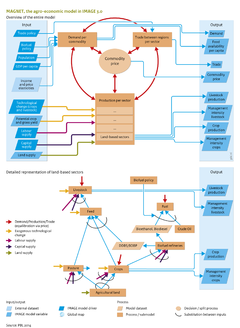Agricultural economy/Description: Difference between revisions
Jump to navigation
Jump to search
No edit summary |
No edit summary |
||
| Line 1: | Line 1: | ||
{{ComponentDescriptionTemplate | {{ComponentDescriptionTemplate | ||
|Status=On hold | |Status=On hold | ||
|Reference=Hertel, 1997; Britz, 2003; Armington, 1969; Huang et al., 2004; Helming et al., 2010; Banse et al., 2008; | |Reference=Hertel, 1997; Britz, 2003; Armington, 1969; Huang et al., 2004; Helming et al., 2010; Banse et al., 2008; Bruinsma, 2003; | ||
|Description=<h2>Model description Agricultural economy and forestry</h2> | |Description=<h2>Model description Agricultural economy and forestry</h2> | ||
The [[MAGNET model]] ([[Woltjer et al., 2011]]) is based on the standard [[GTAP model]] ([[Hertel, 1997]]), which is a multi-regional, static, applied computable general equilibrium ([[CGE]]) model based on neoclassical microeconomic theory. Although it covers the entire economy, there is a special focus on agricultural sectors. The MAGNET model is a further development of GTAP regarding land use, household consumption, livestock, food, feed and energy crop production, and emission reduction cost calculations. | The [[MAGNET model]] ([[Woltjer et al., 2011]]) is based on the standard [[GTAP model]] ([[Hertel, 1997]]), which is a multi-regional, static, applied computable general equilibrium ([[CGE]]) model based on neoclassical microeconomic theory. Although it covers the entire economy, there is a special focus on agricultural sectors. The MAGNET model is a further development of GTAP regarding land use, household consumption, livestock, food, feed and energy crop production, and emission reduction cost calculations. | ||
Revision as of 15:50, 16 December 2013
Parts of Agricultural economy/Description
| Component is implemented in: |
|
| Related IMAGE components |
| Projects/Applications |
| Key publications |
| References |
